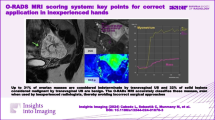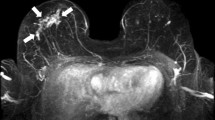Abstract
Purpose
To retrospectively evaluate the ability of magnetic resonance (MR) imaging to differentiate low from high Fuhrman grade renal cell carcinoma (RCC).
Materials and methods
MR images from 80 consecutive pathologically proven RCC (57 clear cell, 16 papillary and 7 chromophobe) were evaluated. Double-echo chemical shift, dynamic contrast-enhanced T1- and T2-weighted images and apparent diffusion coefficient (ADC) maps were reviewed independently. Signal intensity index (SII), tumour-to-spleen SI ratio (TSR), ADC ratio, wash-in (WiI) and wash-out indices (WoI) between different phases were calculated and compared to pathological grade and size. The Fuhrman scoring system was used. Low grade (score ≤2) and high grade (score ≥3) tumours were compared using univariate and multivariate analyses.
Results
No associations between grade and imaging factors were found for papillary and chromophobe RCCs. For clear cell RCCs, there was a significant association between the grade and parenchymal WiI (WiI2) (P = 0.02) or ADCr (P = 0.03). A significant association between tumour grade and size (P = 0.01), WiI2 (P = 0.02) and ADCr (P = 0.05) remained in multivariate analysis.
Conclusions
Multiparametric MRI can be used to accurately differentiate low Fuhrman grade clear cell RCC from high grade. High Fuhrman grade (≥3) RCCs were larger, had lower parenchymal wash-in indices and lower ADC ratios than low grade.
Key Points
• Fuhrman grade of clear cell RCC can be differentiated with multiparametric MR imaging.
• Fuhrman grade significantly differed for size, parenchymal wash-in index and ADC ratio.
• No significant associations were found for papillary and chromophobe renal cell carcinoma.


Similar content being viewed by others
Abbreviations
- ADC:
-
Apparent diffusion coefficient
- au:
-
Arbitrary units
- DCE:
-
Dynamic contrast-enhanced
- Gd:
-
Gadolinium
- GE:
-
Gradient echo
- mpMRI:
-
Multiparametric magnetic resonance imaging
- MR:
-
Magnetic resonance
- RCC:
-
Renal cell carcinoma
- ROI:
-
Region of interest
- SII:
-
Signal intensity index
- SIR:
-
Signal intensity ratio
- TSR:
-
Tumour-to-spleen ratio
- WiI:
-
Wash-in index
- WoI:
-
Wash-out index
References
Siegel R, Naishadham D, Jemal A (2013) Cancer statistics, 2013. CA Cancer J Clin 63:11–30
Kathrins M, Caesar S, Mucksavage P, Guzzo T (2013) Renal mass size: concordance between pathology and radiology. Curr Opin Urol 23:389–393
Hsu JY, Wakelee HA (2009) Monoclonal antibodies targeting vascular endothelial growth factor: current status and future challenges in cancer therapy. BioDrugs Clin Immunotherap Biopharm Gene Ther 23:289–304
Karlo CA, Di Paolo PL, Chaim J et al (2014) Radiogenomics of clear cell renal cell carcinoma: associations between CT imaging features and mutations. Radiology 270:464–471
Cornelis F, Tricaud E, Lasserre AS et al (2014) Routinely performed multiparametric magnetic resonance imaging helps to differentiate common subtypes of renal tumours. Eur Radiol 24:1068–1080
Campbell SC, Novick AC, Belldegrun A et al (2009) Guideline for management of the clinical T1 renal mass. J Urol 182:1271–1279
Breda A, Treat EG, Haft-Candell L et al (2010) Comparison of accuracy of 14-, 18- and 20-G needles in ex-vivo renal mass biopsy: a prospective, blinded study. BJU Int 105:940–945
Herts BR, Baker ME (1995) The current role of percutaneous biopsy in the evaluation of renal masses. Semin Urol Oncol 13:254–261
Heilbrun ME, Zagoria RJ, Garvin AJ et al (2007) CT-guided biopsy for the diagnosis of renal tumors before treatment with percutaneous ablation. AJR 188:1500–1505
Lechevallier E, Andre M, Barriol D et al (2000) Fine-needle percutaneous biopsy of renal masses with helical CT guidance. Radiology 216:506–510
Volpe A, Panzarella T, Rendon RA, Haider MA, Kondylis FI, Jewett MAS (2004) The natural history of incidentally detected small renal masses. Cancer 100:738–745
Ficarra V, Brunelli M, Novara G et al (2011) Accuracy of on-bench biopsies in the evaluation of the histological subtype, grade, and necrosis of renal tumours. Pathology 43:149–155
Al Nazer M, Mourad WA (2000) Successful grading of renal-cell carcinoma in fine-needle aspirates. Diagn Cytopathol 22:223–226
Leveridge MJ, Finelli A, Kachura JR et al (2011) Outcomes of small renal mass needle core biopsy, nondiagnostic percutaneous biopsy, and the role of repeat biopsy. Eur Urol 60:578–584
Vargas HA, Delaney HG, Delappe EM et al (2013) Multiphasic contrast-enhanced MRI: single-slice versus volumetric quantification of tumor enhancement for the assessment of renal clear-cell carcinoma fuhrman grade. J Magn Reson Imaging 37:1160–1167
Pedrosa I, Chou MT, Ngo L et al (2008) MR classification of renal masses with pathologic correlation. Eur Radiol 18:365–375
Cornelis F, Lasserre AS, Tourdias T et al (2013) Combined late gadolinium-enhanced and double-echo chemical-shift MRI help to differentiate renal oncocytomas with high central t2 signal intensity from renal cell carcinomas. AJR Am J Roentgenol 200:830–838
Sasiwimonphan K, Takahashi N, Leibovich BC, Carter RE, Atwell TD, Kawashima A (2012) Small (<4 cm) renal mass: differentiation of angiomyolipoma without visible fat from renal cell carcinoma utilizing MR imaging. Radiology 263:160–168
Rosenkrantz AB, Niver BE, Fitzgerald EF, Babb JS, Chandarana H, Melamed J (2010) Utility of the apparent diffusion coefficient for distinguishing clear cell renal cell carcinoma of low and high nuclear grade. AJR Am J Roentgenol 195:344–351
Kim JK, Kim SH, Jang YJ et al (2006) Renal angiomyolipoma with minimal fat: differentiation from other neoplasms at double-echo chemical shift FLASH MR imaging. Radiology 239:174–180
Fuhrman SA, Lasky LC, Limas C (1982) Prognostic significance of morphologic parameters in renal cell carcinoma. Am J Surg Pathol 6:655–663
Busing KA, Kilian AK, Schaible T, Debus A, Weiss C, Neff KW (2008) Reliability and validity of MR image lung volume measurement in fetuses with congenital diaphragmatic hernia and in vitro lung models. Radiology 246:553–561
Shrout PE, Fleiss JL (1979) Intraclass correlations: uses in assessing rater reliability. Psychol Bull 86:420–428
Bland JM, Altman DG (1995) Multiple significance tests: the Bonferroni method. BMJ 310:170
True LD (2002) The time for accurate Fuhrman grading of renal cell carcinomas has arrived. Am J Clin Pathol 118:827–829
Kroeger N, Seligson DB, Klatte T et al (2012) Clinical, molecular, and genetic correlates of lymphatic spread in clear cell renal cell carcinoma. Eur Urol 61:888–895
Meskawi M, Sun M, Ismail S et al (2013) Fuhrman grade [corrected] has no added value in prediction of mortality after partial or [corrected] radical nephrectomy for chromophobe renal cell carcinoma patients. Mod Pathol 26:1144–1149
Goldstein NS (1997) The current state of renal cell carcinoma grading. Union Internationale Contre le Cancer (UICC) and the American Joint Committee on Cancer (AJCC). Cancer 80:977–980
Cheville JC, Lohse CM, Zincke H, Weaver AL, Blute ML (2003) Comparisons of outcome and prognostic features among histologic subtypes of renal cell carcinoma. Am J Surg Pathol 27:612–624
Patard JJ, Leray E, Rioux-Leclercq N et al (2005) Prognostic value of histologic subtypes in renal cell carcinoma: a multicenter experience. J Clin Oncol 23:2763–2771
Somford DM, Hambrock T, Hulsbergen-van de Kaa CA et al (2012) Initial experience with identifying high-grade prostate cancer using diffusion-weighted MR imaging (DWI) in patients with a Gleason score ≤ 3 + 3 = 6 upon schematic TRUS-guided biopsy: a radical prostatectomy correlated series. Investig Radiol 47:153–158
Oto A, Yang C, Kayhan A et al (2011) Diffusion-weighted and dynamic contrast-enhanced MRI of prostate cancer: correlation of quantitative MR parameters with Gleason score and tumor angiogenesis. AJR Am J Roentgenol 197:1382–1390
Goyal A, Sharma R, Bhalla AS et al (2012) Diffusion-weighted MRI in renal cell carcinoma: a surrogate marker for predicting nuclear grade and histological subtype. Acta Radiol 53:349–358
Sandrasegaran K, Sundaram CP, Ramaswamy R et al (2010) Usefulness of diffusion-weighted imaging in the evaluation of renal masses. AJR Am J Roentgenol 194:438–445
Lam JS, Shvarts O, Said JW et al (2005) Clinicopathologic and molecular correlations of necrosis in the primary tumor of patients with renal cell carcinoma. Cancer 103:2517–2525
Klatte T, Said JW, de Martino M et al (2009) Presence of tumor necrosis is not a significant predictor of survival in clear cell renal cell carcinoma: higher prognostic accuracy of extent based rather than presence/absence classification. J Urol 181:1558–1564
Minervini A, Di Cristofano C, Gacci M et al (2008) Prognostic role of histological necrosis for nonmetastatic clear cell renal cell carcinoma: correlation with pathological features and molecular markers. J Urol 180:1284–1289
Delahunt B, McKenney JK, Lohse CM et al (2013) A novel grading system for clear cell renal cell carcinoma incorporating tumor necrosis. Am J Surg Pathol 37:311–322
Thompson RH, Kurta JM, Kaag M et al (2009) Tumor size is associated with malignant potential in renal cell carcinoma cases. J Urol 181:2033–2036
Crispen PL, Wong Y-N, Greenberg RE, Chen DYT, Uzzo RG (2008) Predicting growth of solid renal masses under active surveillance. Urol Oncol 26:555–559
Hsu RM, Chan DY, Siegelman SS (2004) Small renal cell carcinomas: correlation of size with tumor stage, nuclear grade, and histologic subtype. AJR Am J Roentgenol 182:551–557
Delahunt B, Bethwaite PB, Nacey JN (2007) Outcome prediction for renal cell carcinoma: evaluation of prognostic factors for tumours divided according to histological subtype. Pathology 39:459–465
Zhang C, Li X, Hao H, Yu W, He Z, Zhou L (2012) The correlation between size of renal cell carcinoma and its histopathological characteristics: a single center study of 1867 renal cell carcinoma cases. BJU Int 110:E481–E485
Maruyama M, Yoshizako T, Uchida K et al (2014) Comparison of utility of tumor size and apparent diffusion coefficient for differentiation of low- and high-grade clear-cell renal cell carcinoma. Acta Radiol
Millet I, Doyon FC, Hoa D et al (2011) Characterization of small solid renal lesions: can benign and malignant tumors be differentiated with CT? AJR Am J Roentgenol 197:887–896
Acknowledgements
The authors thank Pippa McKelvie-Sebileau for medical editorial services.
The scientific guarantor of this publication is Prof. Nicolas Grenier. The authors of this manuscript declare no relationships with any companies whose products or services may be related to the subject matter of the article. The authors state that this work has not received any funding. One of the authors has significant statistical expertise. No complex statistical methods were necessary for this paper. Institutional review board approval was obtained. Written informed consent was waived by the Institutional review board. Methodology: retrospective, diagnostic or prognostic study, performed at one institution.
Author information
Authors and Affiliations
Corresponding author
Rights and permissions
About this article
Cite this article
Cornelis, F., Tricaud, E., Lasserre, A.S. et al. Multiparametric magnetic resonance imaging for the differentiation of low and high grade clear cell renal carcinoma. Eur Radiol 25, 24–31 (2015). https://doi.org/10.1007/s00330-014-3380-x
Received:
Revised:
Accepted:
Published:
Issue Date:
DOI: https://doi.org/10.1007/s00330-014-3380-x




